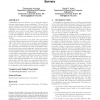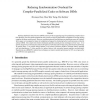30 search results - page 1 / 6 » Impact of Load Imbalance on the Design of Software Barriers |
ICPP
1995
IEEE
13 years 8 months ago
1995
IEEE
Software barriers have been designed and evaluated for barrier synchronization in large-scale shared-memory multiprocessors, under the assumption that all processorsreach the sync...
ICC
2007
IEEE
13 years 11 months ago
2007
IEEE
—Uplink-Downlink imbalance is a characteristic of all wireless networks which greatly impacts system performance, and must be accounted for in system design and simulation. Howev...
WOSP
2010
ACM
13 years 9 months ago
2010
ACM
Virtualization has been shown to be an attractive path to increase overall system resource utilization. The use of live virtual machine (VM) migration has enabled more effective ...
DAC
2005
ACM
13 years 6 months ago
2005
ACM
In this paper we present the impact of dynamically translating any sequence of instructions into combinational logic. The proposed approach combines a reconfigurable architecture ...
LCPC
1997
Springer
13 years 8 months ago
1997
Springer
Software distributed-shared-memory (DSM) systems providean appealingtarget for parallelizing compilers due to their flexibility. Previous studies demonstrate such systems can prov...


